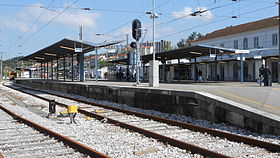Coimbra-B train station
| Coimbra-B | |
|---|---|
| Data | |
| Location in the network | Separation station |
| Platform tracks | 5 |
| IBNR | 9400253 |
| opening | 1864 |
| location | |
| City / municipality | Coimbra |
| District | Coimbra |
| Country | Portugal |
| Coordinates | 40 ° 13 ′ 31 ″ N , 8 ° 26 ′ 27 ″ W |
| Railway lines | |
|
|
| List of train stations in Portugal | |
The Coimbra-B station , also Estação velha de Coimbra called, is the most important station of the Portuguese city of Coimbra . It is located at the junction of Linha do Norte and Ramal da Lousã and is served by all Linha do Norte trains. The station is located northwest of the city center in the São Bartolomeu district, while the Coimbra-A station is also located in the center of Coimbra .
history
The station went into operation on April 10, 1864 at the same time as the Estarreja – Taveiro section of what is now Linha do Norte. On July 7th of the same year, direct trains to Lisbon could be offered for the first time after the necessary section to Entroncamento had been completed. Trains to Porto did not run until 1872, before a crossing over the Douro in Vila Nova de Gaia was necessary. In 1885 a branch line ( Ramal de Coimbra ) to the Coimbra-A train station in the city center was completed to improve accessibility , and in 1903 it was extended to Ramal da Lousã after Lousã . In 1876 there were initially plans to lead the Linha da Beira Alta to Coimbra-B, but two years later it was decided that this route to the Spanish-Portuguese border would be connected to the Linha do Norte at Vilar Formoso in Pampilhosa .
In 2006 the Ramal da Lousã was shut down with the aim of converting it into a line of the Mondego Metro network . Due to the desperate budget situation in Portugal, the project has currently been stopped and train traffic in the form of regional and suburban trains will only be handled as far as Coimbra-A.
Location and facility
The station is located in the Freguesia São Bartolomeu northwest of Coimbra's city center, near the Mondego . The reception building has a white facade and has various facilities such as ticket counters for the Comboios de Portugal , restaurants and retail outlets. Coimbra-B comprises 5 platform tracks with a length between 240 and 400 meters. The platforms are between 223 and 297 meters long and 45 to 95 centimeters high.
traffic
The station is the stopping point for all Linha do Norte trains. The pair of trains of the Sud-Express on the Irún / Hendaye – Lisbon Santa Apolónia route stops once a day . In addition, there are Alfa Pendular tilting trains running every hour between Lisbon Santa Apolónia and Porto-Campanhã, which are extended three times a day to Braga and twice a day to Faro (the latter without service to Santa Apolónia). In long-distance traffic, these trains are supplemented by various Intercidades connections to Porto, Lisbon, Guarda and Guimarães.
In regional traffic, regional and suburban trains offer connections to Figueira da Foz, Aveiro, Coimbra-A, Entroncamento and Guarda. Occasional inter- regional trains run via Leiria to Caldas da Rainha on the Linha do Oeste .
future
With the renovation of the Ramal da Lousã, Coimbra-B is to be connected to the Mondego Metro network. In a further phase, a line to Figueira da Foz will also be set up.
Another train station should have been built in the Coimbra area as part of the Lisbon – Madrid high-speed line . The initially planned linking of high-speed trains and conventional trains in the Coimbra-B station could not have been implemented for reasons of space, so a new station would have to be built in the Taveiro area. Since the Portuguese government canceled the high-speed line project for financial reasons, no change in the long-distance service for Coimbra-B is expected in the near future.
Web links
Individual evidence
- ↑ Report of the Gazeta dos Caminhos de Ferro (PDF; 8.7 MB)
- ↑ Gazeta dos Caminhos de Ferro 70 (1681): 11, 12.
